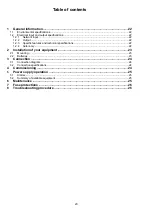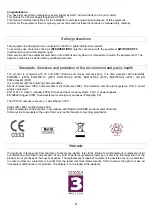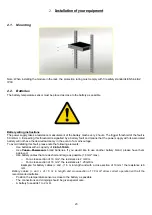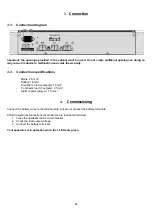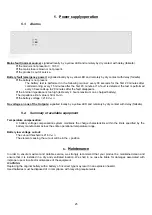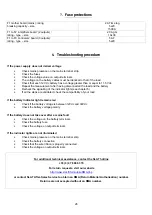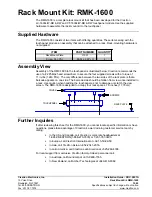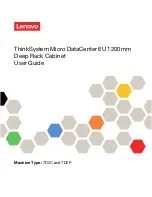
25
5.
Power supply operation
5.1.
Alarms
Mains fault (normal source)
: signalled locally by a yellow LED and remotely by dry contact with delay (failsafe).
If
the mains is not present or < 195 V.
If
the
mains fuse is blown or not present.
If
the product is out of service.
Battery fault (emergency power)
: signalled locally by a yellow LED and remotely by dry contact with delay (failsafe).
If
the battery is not present:
The battery test is performed in the following manner: every 30 seconds for the first 20 minutes after
commissioning: every 15 minutes after the first 20 minutes. If a f ault is detected, the test is performed
every 30 seconds up to 20 minutes after the fault disappears.
If
the internal impedance is too high (test every 4 hours maximum on a charged battery).
The impedance limit value is 50 m
Ω
±10 %.
If
the battery voltage < 21.6V
±3 %.
No voltage on one of the Outputs:
signalled locally by a yellow LED and remotely by dry contact with delay (failsafe).
5.2.
Summary of available equipment
Temperature compensation:
A battery voltage compensation system maintains the charge characteristics within the limits specified by the
battery manufacturer across the entire operational temperature range.
Battery low voltage cut-out:
The cut-out threshold is 21.6V
±3 %.
The element causing the cut-out will be in the + position.
6.
Maintenance
In order to ensure maximal and durable service, we strongly recommend that your product be maintained clean and
ensure that it is installed in a dry and ventilated location. We shall in no case be liable for damages associated with
improper use or incorrect maintenance of the equipment.
WARNING
Replacing the original battery with a battery of incorrect type may result in an explosion hazard.
Used batteries must be disposed of in compliance with recycling requirements.










